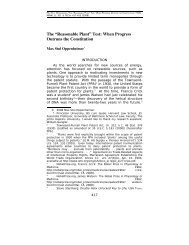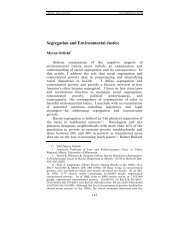An Organizational Approach to the Design of Patent Law
An Organizational Approach to the Design of Patent Law
An Organizational Approach to the Design of Patent Law
You also want an ePaper? Increase the reach of your titles
YUMPU automatically turns print PDFs into web optimized ePapers that Google loves.
6 VERTINSKY FINAL_JAD (DO NOT DELETE) 2/27/2012 2:20 PM<br />
278 MINN. J. L. SCI. & TECH. [Vol. 13:1<br />
This Article has made <strong>the</strong> case for a reorientation <strong>of</strong> patent<br />
policy <strong>to</strong> focus on <strong>the</strong> mechanisms through which patents alter<br />
<strong>the</strong> nature and cost <strong>of</strong> transactions supporting systems <strong>of</strong> innovation.<br />
The organizational approach that I have proposed promotes<br />
<strong>the</strong> design <strong>of</strong> patent laws that are more narrowly tailored<br />
<strong>to</strong> <strong>the</strong> particular needs <strong>of</strong> alternative innovation<br />
processes, focused on reducing <strong>the</strong> propensity for behaviors<br />
which are most costly <strong>to</strong> <strong>the</strong> organization <strong>of</strong> economic activities,<br />
robust <strong>to</strong> constraints on rule design and implementation, and<br />
sensitive <strong>to</strong> alternative mechanisms for regulating behavior. By<br />
adopting such an approach, policymakers can produce more effective<br />
strategies for patent policy design in real world settings<br />
characterized by bounded rationality, market imperfections,<br />
and constraints on efficient rule change. Existing applications<br />
<strong>of</strong> New Institutional Economics <strong>to</strong> patent law have <strong>of</strong>fered important<br />
insights in<strong>to</strong> how patents impact <strong>the</strong> organization <strong>of</strong><br />
economic activities. But such efforts have thus far remained on<br />
<strong>the</strong> sidelines in policy discussions, operating largely in isolation<br />
from o<strong>the</strong>r <strong>the</strong>ories and at a level that is ei<strong>the</strong>r <strong>to</strong>o abstract or<br />
<strong>to</strong>o descriptive <strong>to</strong> map readily in<strong>to</strong> practical policy prescriptions<br />
Recognizing that some level <strong>of</strong> abstraction from reality is essential<br />
in policy design, <strong>the</strong> organizational approach provides a<br />
way <strong>of</strong> capturing critical features <strong>of</strong> real world innovation processes<br />
without losing analytical rigor and empirical testability.<br />
It <strong>of</strong>fers an opportunity for integrating existing patent <strong>the</strong>ories<br />
and empirical work in a way that can test <strong>the</strong> <strong>the</strong>ories’ robustness<br />
and give <strong>the</strong>m greater explana<strong>to</strong>ry power, and it <strong>of</strong>fers<br />
new avenues for exploring different functions <strong>of</strong> patents that<br />
may have been neglected or overlooked by mainstream approaches.<br />
Most importantly, it provides a way <strong>of</strong> demonstrating<br />
<strong>the</strong> relevance <strong>of</strong> patents <strong>to</strong> key objectives <strong>of</strong> modern national<br />
innovation strategies.<br />
Significant challenges remain in this form <strong>of</strong> analysis.<br />
Questions arise, for example, about how <strong>to</strong> apply an analysis <strong>of</strong><br />
transaction costs <strong>to</strong> dynamic systems <strong>of</strong> innovation in a way<br />
that can be both modeled and measured, and about how <strong>to</strong><br />
identify <strong>the</strong> types <strong>of</strong> transactions and modes <strong>of</strong> organization<br />
that will be most favorable <strong>to</strong> evolving systems <strong>of</strong> innovation.<br />
Given <strong>the</strong> dynamic nature <strong>of</strong> innovation, institutions must constantly<br />
adjust if <strong>the</strong>y are <strong>to</strong> keep pace in a rapidly changing society,<br />
but <strong>the</strong> ways <strong>of</strong> making institutions such as <strong>the</strong> patent






